Potential Use of IFMIF-DONES Target Back-Plate for Material Specimens
Abstract
:1. Introduction
2. Simulation Models, Tools, and Data
3. Simulation Results and Discussion
4. Preliminary Analysis of Sample Productions
4.1. Specimen Arrangements and Available Volume
4.2. Study of Specimen Arragements with Increased BP Thickness
5. Conclusions and Discussions
Author Contributions
Funding
Institutional Review Board Statement
Informed Consent Statement
Data Availability Statement
Conflicts of Interest
References
- Ibarra, A.; Arbeiter, F.; Bernardi, D.; Krolas, W.; Cappelli, M.; Fischer, U.; Heidinger, R.; Martin-Fuertes, F.; Micciché, G.; Muñoz, A.; et al. The European approach to the fusion-like neutron source: The IFMIF-DONES project. Nucl. Fusion 2019, 59, 065002. [Google Scholar] [CrossRef] [Green Version]
- Rieth, M.; Schirra, M.; Falkenstein, A.; Graf, P.; Heger, S.; Kempe, H.; Lindau, R.; Zimmermann, H. EUROFER 97 Tensile, Charpy, Creep and Structural Tests; Forschungszentrum Karlsruhe GmbH Technik und Umwelt: Berlin, Germany, 2003. [Google Scholar]
- Norgett, M.; Robinson, M.; Torrens, I. A proposed method of calculating displacement dose rates. Nucl. Eng. Des. 1975, 33, 50–54. [Google Scholar] [CrossRef]
- Qiu, Y.; Arbeiter, F.; Fischer, U.; Schwab, F. IFMIF-DONES HFTM neutronics modeling and nuclear response analyses. Nucl. Mater. Energy 2018, 15, 185–189. [Google Scholar] [CrossRef]
- Arena, P.; Bernardi, D.; Di Maio, P.A.; Frisoni, M.; Gordeev, S.; Miccichè, G.; Nitti, F.S.; Ibarra, A. The design of the DONES lithium target system. Fusion Eng. Des. 2019, 146, 1135–1139. [Google Scholar] [CrossRef]
- Arbeiter, F.; Diegele, E.; Fischer, U.; Garcia, A.; Ibarra, A.; Molla, J.; Mota, F.; Möslang, A.; Qiu, Y.; Serrano, M.; et al. Planned material irradiation capabilities of IFMIF-DONES. Nucl. Mater. Energy 2018, 16, 245–248. [Google Scholar] [CrossRef]
- Goorley, J.T.; James, M.R.; Booth, T.E.; Bull, J.S.; Cox, L.J.; Durkee, J.W.J.; Elson, J.S.; Fensin, M.L.; Forster, R.A.I.; Hendricks, J.S.; et al. Initial MCNP6 Release Overview—MCNP6 Version 1.0; Los Alamos National Lab. (LANL): Los Alamos, NM, USA, 2013. [CrossRef]
- Lu, L.; Qiu, Y.; Fischer, U. Improved solid decomposition algorithms for the CAD-to-MC conversion tool McCad. Fusion Eng. Des. 2017, 124, 1269–1272. [Google Scholar] [CrossRef] [Green Version]
- Simakov, S.P.; Fischer, U.; Kondo, K.; Pereslavtsev, P. Status of the McDeLicious Approach for the D-Li Neutron Source Term Modeling in IFMIF Neutronics Calculations. Fusion Sci. Technol. 2012, 62, 233–239. [Google Scholar] [CrossRef]
- Pereslavtsev, P.; Fischer, U.; Simakov, S.; Avrigeanu, M. Evaluation of d +6,7Li data for deuteron incident energies up to 50 MeV. Nucl. Instrum. Methods Phys. Res. Sect. B Beam Interact. Mater. At. 2008, 266, 3501–3512. [Google Scholar] [CrossRef]
- Forrest, R.A. FENDL-3 Summary Documentation; Report INDC(NDS)-0628; International Atomic Energy Agency (IAEA): Vienna, Austria, 2012. [Google Scholar]
- Konobeyev, A.Y.; Fischer, U.; Pereslavtsev, P.E. Evaluation of advanced displacement cross-sections for the major EUROFER constituents based on an atomistic modelling approach. Kerntechnik 2015, 80, 7–12. [Google Scholar] [CrossRef]
- Fischer, U.; Bachmann, C.; Catalan, J.P.; Eade, T.; Flammini, D.; Gilbert, M.; Jaboulay, J.C.; Konobeev, A.; Leichtle, D.; Lu, L.; et al. Methodological approach for DEMO neutronics in the European PPPT programme: Tools, data and analyses. Fusion Eng. Des. 2017, 123, 26–31. [Google Scholar] [CrossRef]
- Fischer, U.; Bienkowska, B.; Drozdowicz, K.; Frisoni, M.; Mota, F.; Ogando, F.; Qiu, Y.; Stankunas, G.; Tracz, G. Neutronics of the IFMIF-DONES irradiation facility. Fusion Eng. Des. 2019, 146, 1276–1281. [Google Scholar] [CrossRef] [Green Version]
- Qiu, Y.; Lu, P.; Fischer, U.; Pereslavtsev, P.; Kecskes, S. A generic data translation scheme for the coupling of high-fidelity fusion neutronics and CFD calculations. Fusion Eng. Des. 2014, 89, 1330–1335. [Google Scholar] [CrossRef]
- Knaster, J.; Moeslang, A.; Muroga, T. Materials research for fusion. Nat. Phys. 2016, 12, 424–434. [Google Scholar] [CrossRef]
- Federici, G.; Boccaccini, L.; Cismondi, F.; Gasparotto, M.; Poitevin, Y.; Ricapito, I. An overview of the EU breeding blanket design strategy as an integral part of the DEMO design effort. Fusion Eng. Des. 2019, 141, 30–42. [Google Scholar] [CrossRef]
- Serrano, M.; Hernández, R.; Plaza, D. Muñoz, Assessment of SSTT Technology 2020, EUROfusion IDM EFDA_D_2NJ8LL v1.0. 2020. Available online: https://idm.euro-fusion.org/default.aspx?uid=2MLMCM (accessed on 1 October 2022).
- Choubey, A.; Agrawal, D.K.; Vishwakarma, S.C.; Upadhyaya, B.N.; Ali, S.; Jain, R.K.; Sah, S.K.; Arya, R.; Oak, S.M.; Joseph, J.; et al. Laser cutting of fast breeder test reactor fuel subassembly in hot cell. In Proceedings of the National Laser Symposium, Vadodara, India, 3–5 October 2007. [Google Scholar]
- Tosun, N.; Cogun, C.; Tosun, G. A study on kerf and material removal rate in wire electrical discharge machining based on Taguchi method. J. Mater. Process. Technol. 2004, 152, 316–322. [Google Scholar] [CrossRef]


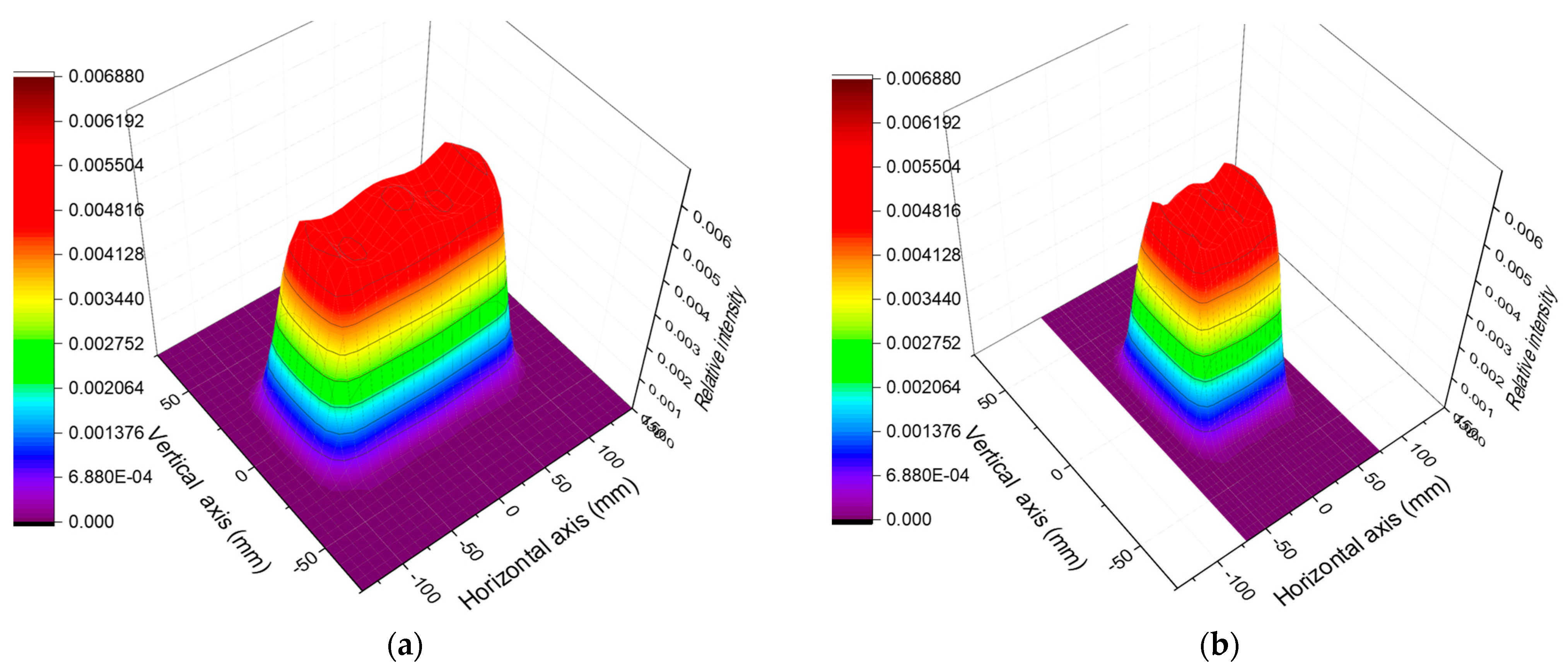

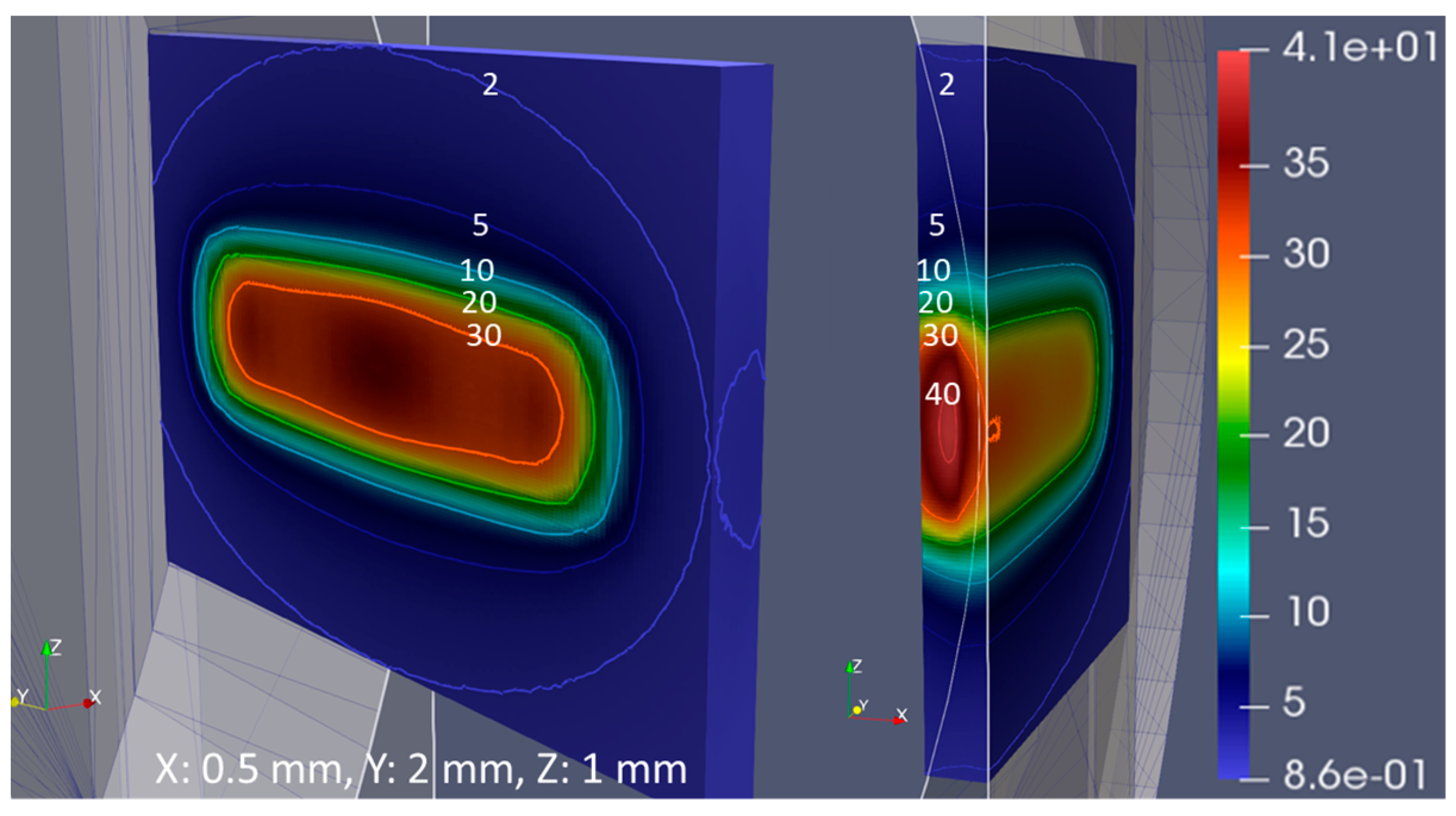
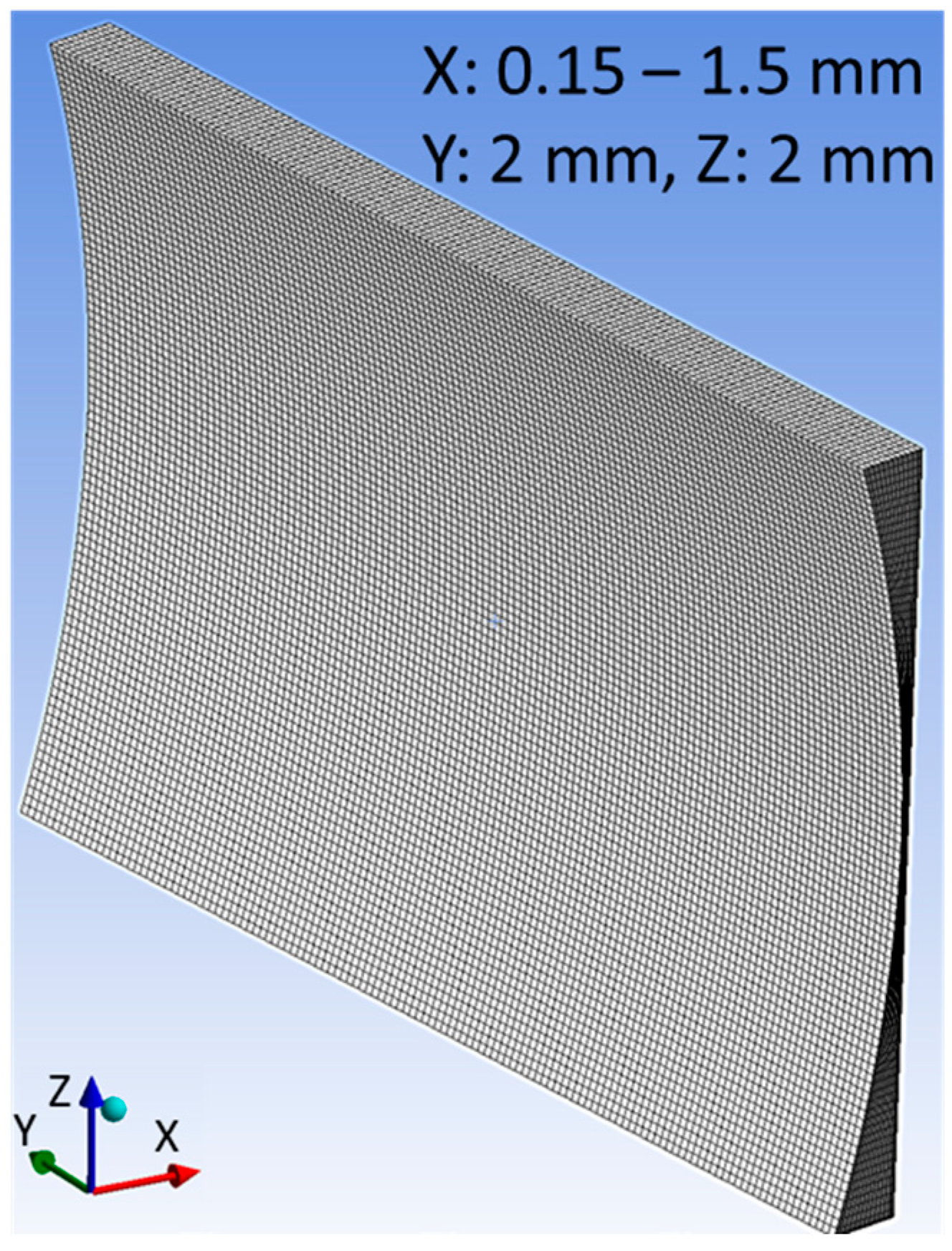

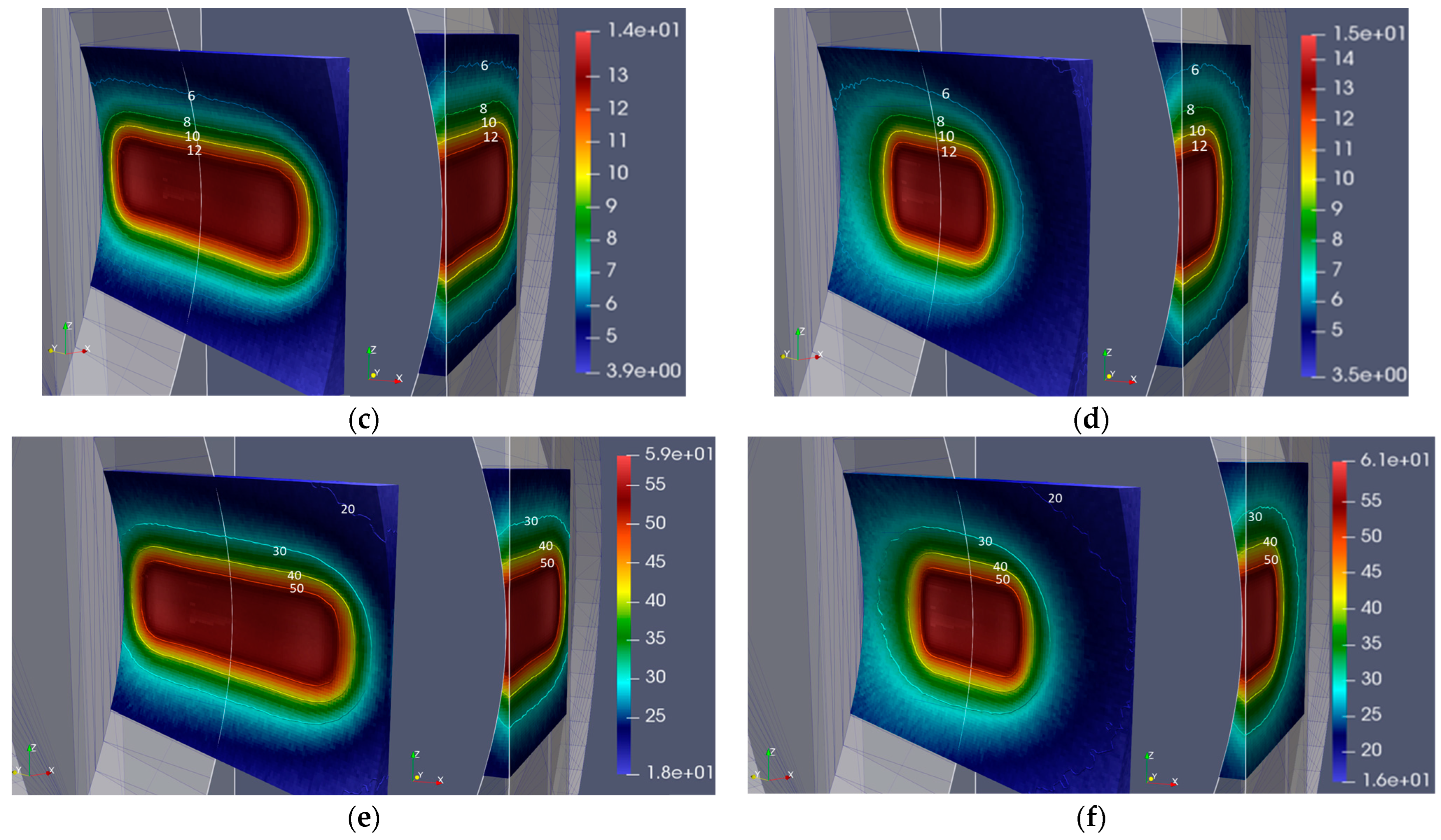

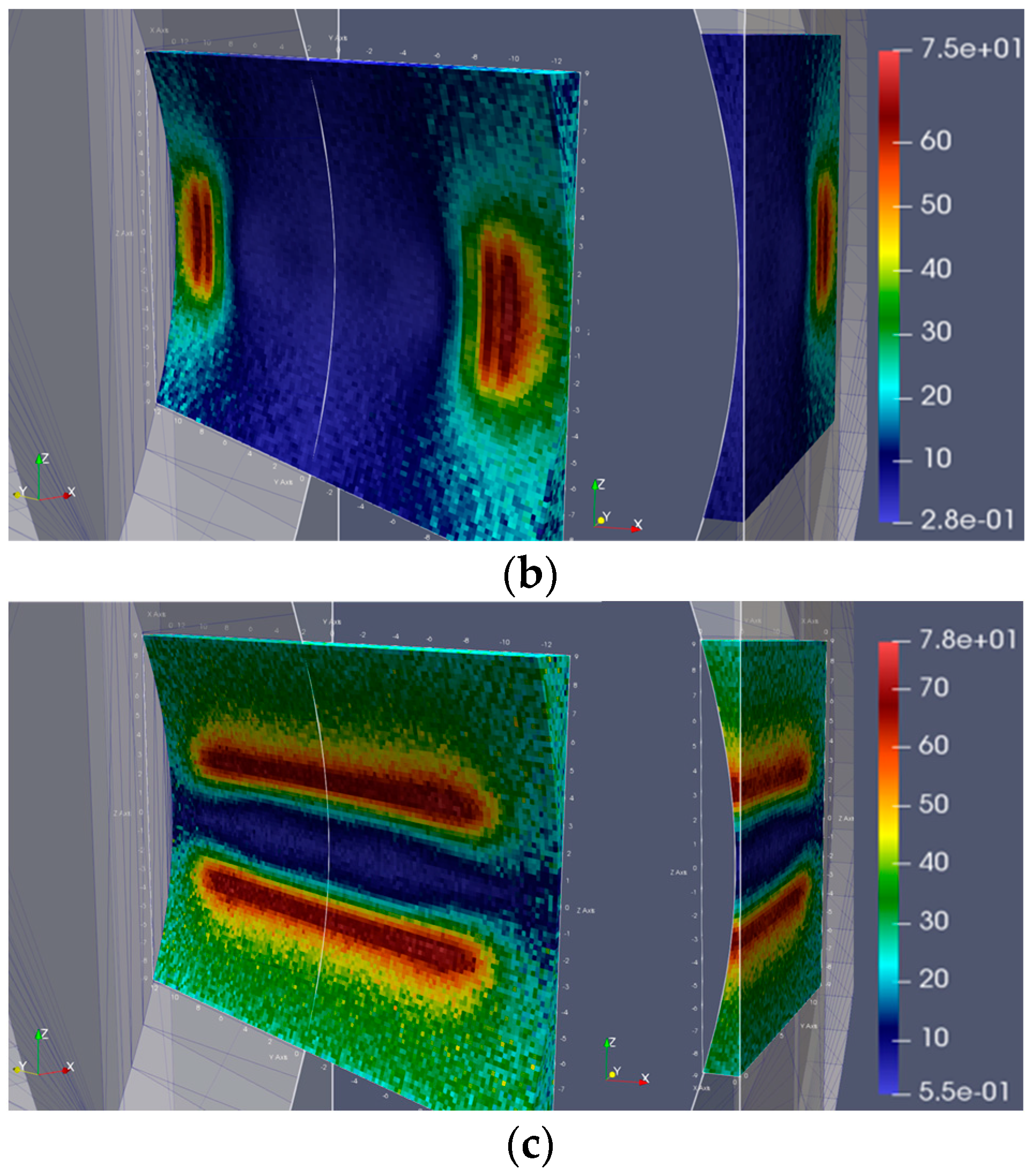

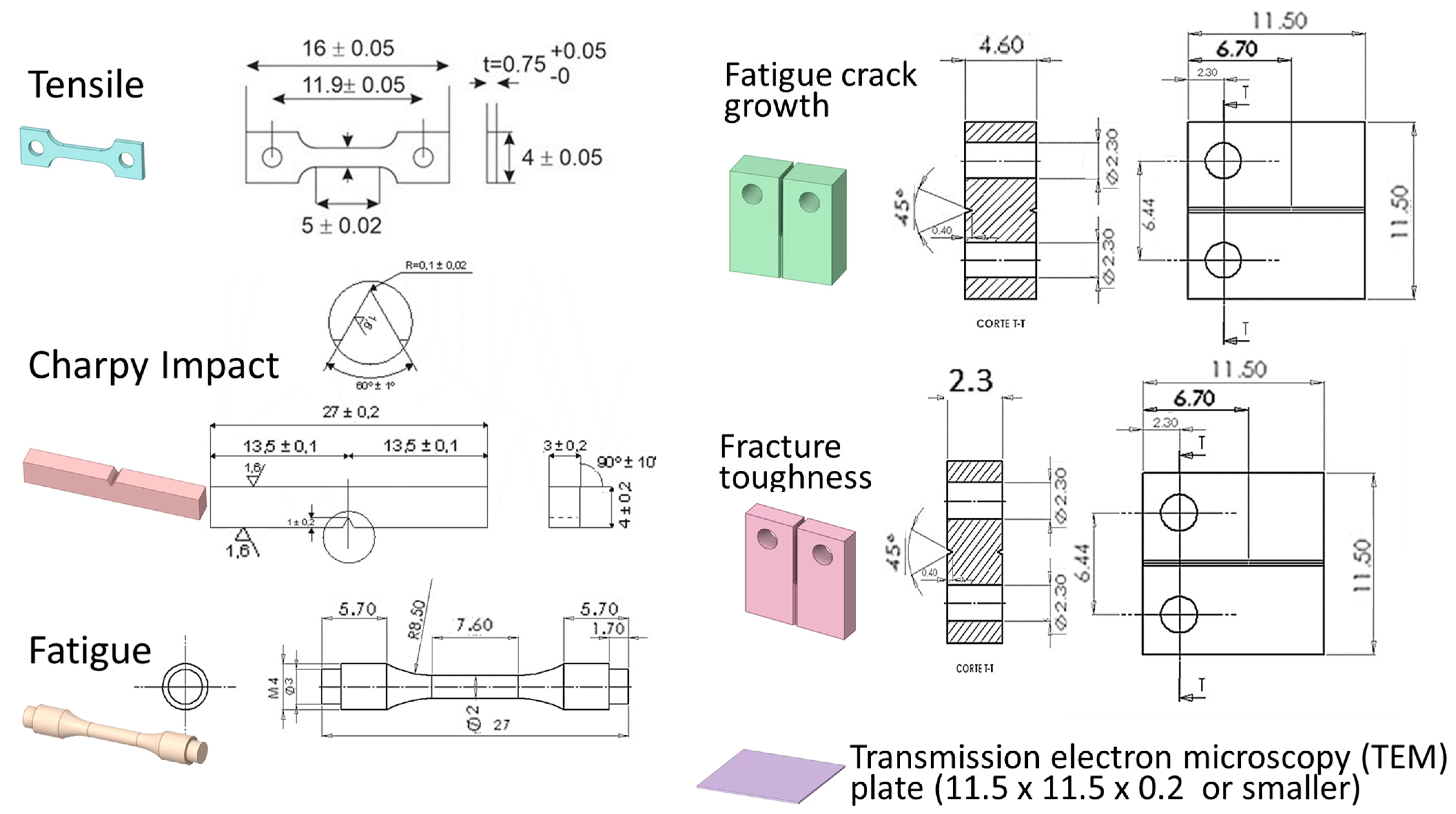
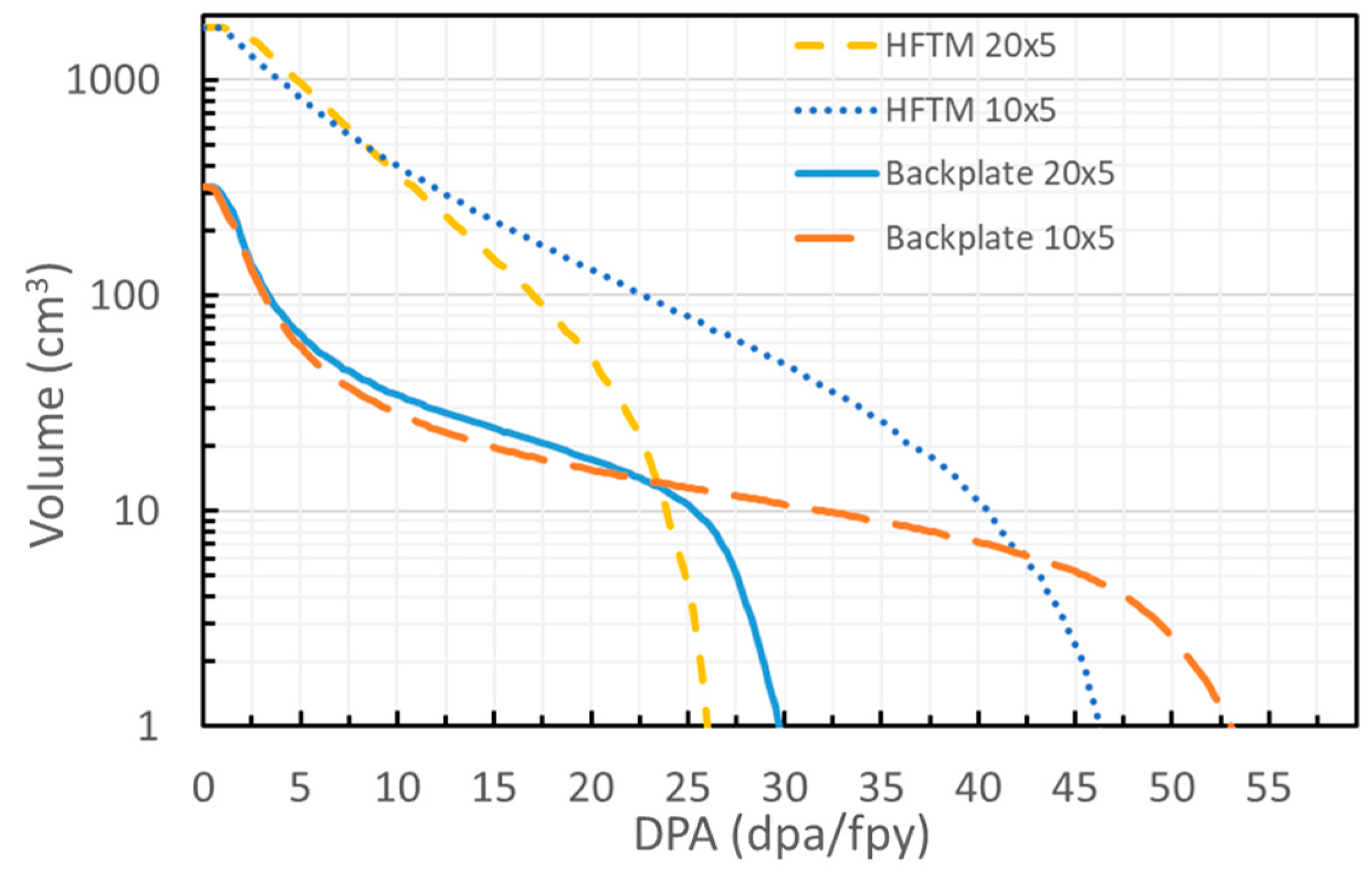
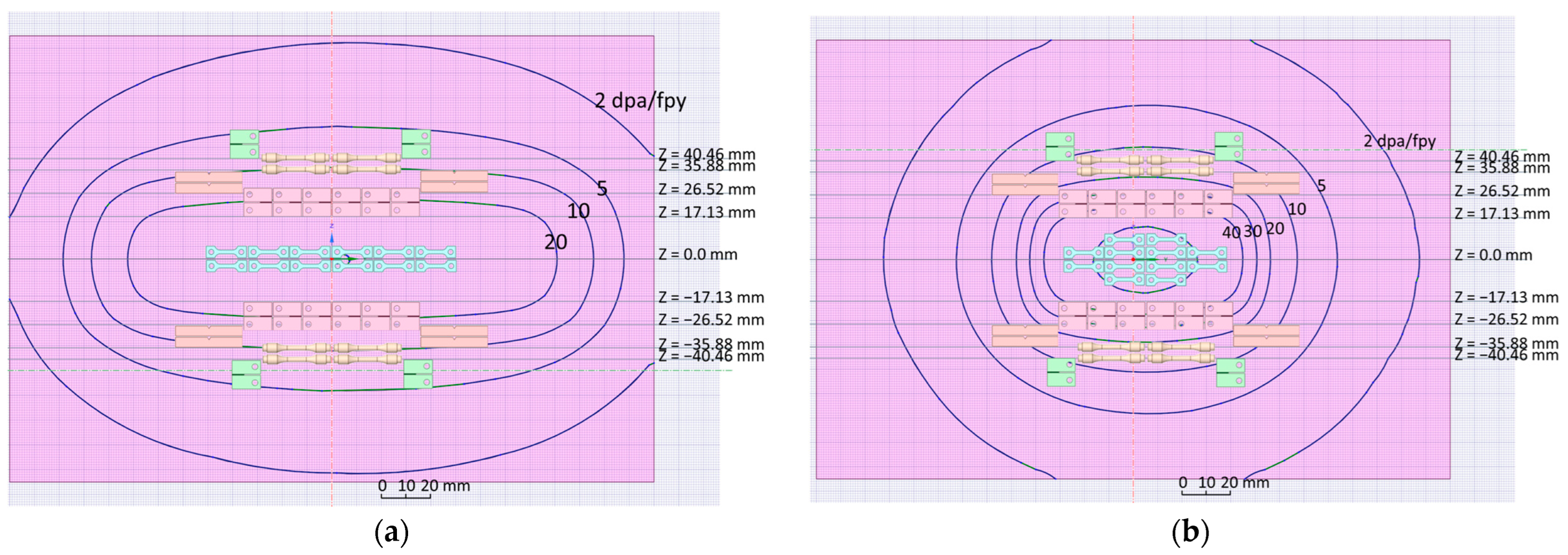

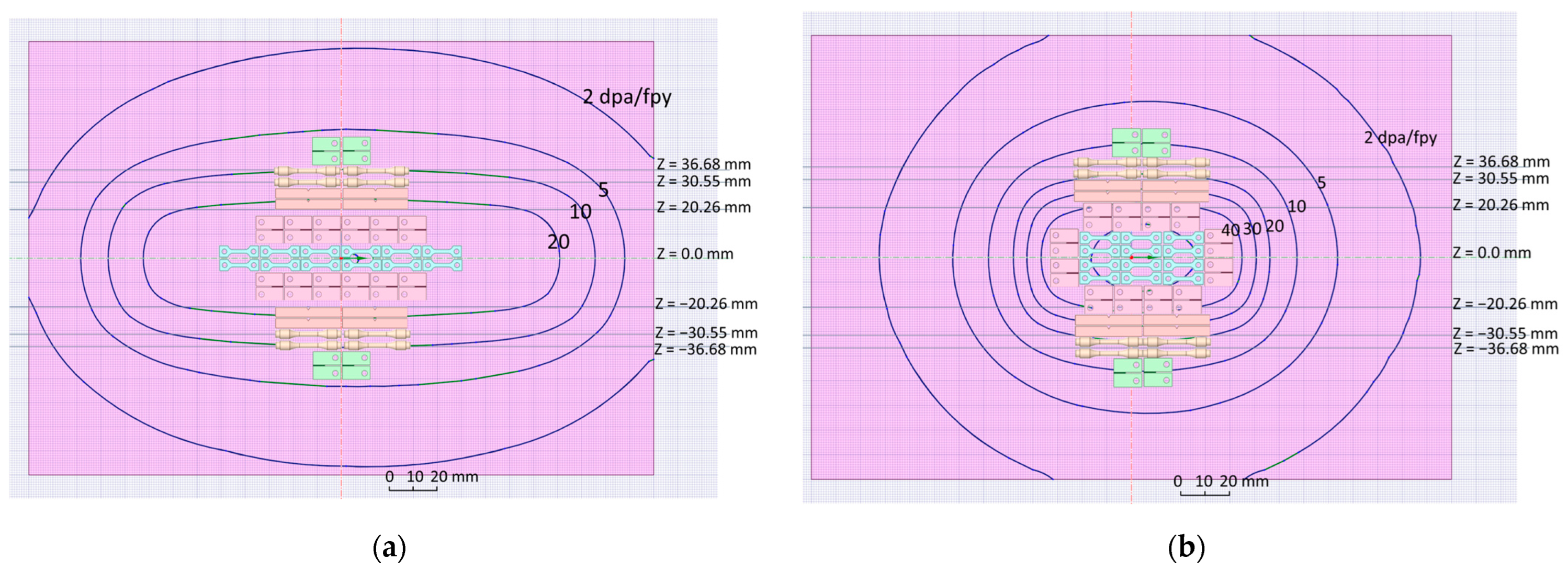
| Specimens | Enclosure 1 (mm3) | Minimum Samples | Minimum Volume (mm3) | Thickness (mm) |
|---|---|---|---|---|
| Tensile | 73.9 | 8–12 | 886.5 | 0.75 |
| Fatigue crack growth | 342.2 | 12 | 4106.7 | 2.3 |
| Charpy impact | 365.6 | 6–8 | 2924.5 | 3 |
| Fracture toughness | 657.1 | 4 | 2628.3 | 4.6 |
| Fatigue | 479.7 | 6–8 | 3838.0 | 4 |
| Specimens | “20 × 5” (dpa/fpy) | “10 × 5” (dpa/fpy) |
|---|---|---|
| Tensile | 25–30 | 45–55 |
| Fatigue crack growth | 19–21 | 30–40 |
| Charpy impact | 10–15 | 8–12 |
| Fracture toughness | 8–10 | 15–20 |
| Fatigue | 6–8 | 7–10 |
| Specimens | “20 × 5” (dpa/fpy) | “10 × 5” (dpa/fpy) |
|---|---|---|
| Tensile | 25–30 | 48–55 |
| Fatigue crack growth | 22–25 | 40–50 |
| Charpy impact | 18–22 | 25–40 |
| Fracture toughness | 10–15 | 15–22 |
| Fatigue | 7–9 | 8–13 |
Publisher’s Note: MDPI stays neutral with regard to jurisdictional claims in published maps and institutional affiliations. |
© 2022 by the authors. Licensee MDPI, Basel, Switzerland. This article is an open access article distributed under the terms and conditions of the Creative Commons Attribution (CC BY) license (https://creativecommons.org/licenses/by/4.0/).
Share and Cite
Qiu, Y.; Arbeiter, F.; Bernardi, D.; Frisoni, M.; Gordeev, S.; Hernández, R.; Serikov, A. Potential Use of IFMIF-DONES Target Back-Plate for Material Specimens. J. Nucl. Eng. 2022, 3, 385-397. https://doi.org/10.3390/jne3040025
Qiu Y, Arbeiter F, Bernardi D, Frisoni M, Gordeev S, Hernández R, Serikov A. Potential Use of IFMIF-DONES Target Back-Plate for Material Specimens. Journal of Nuclear Engineering. 2022; 3(4):385-397. https://doi.org/10.3390/jne3040025
Chicago/Turabian StyleQiu, Yuefeng, Frederik Arbeiter, Davide Bernardi, Manuela Frisoni, Sergej Gordeev, Rebeca Hernández, and Arkady Serikov. 2022. "Potential Use of IFMIF-DONES Target Back-Plate for Material Specimens" Journal of Nuclear Engineering 3, no. 4: 385-397. https://doi.org/10.3390/jne3040025
APA StyleQiu, Y., Arbeiter, F., Bernardi, D., Frisoni, M., Gordeev, S., Hernández, R., & Serikov, A. (2022). Potential Use of IFMIF-DONES Target Back-Plate for Material Specimens. Journal of Nuclear Engineering, 3(4), 385-397. https://doi.org/10.3390/jne3040025








